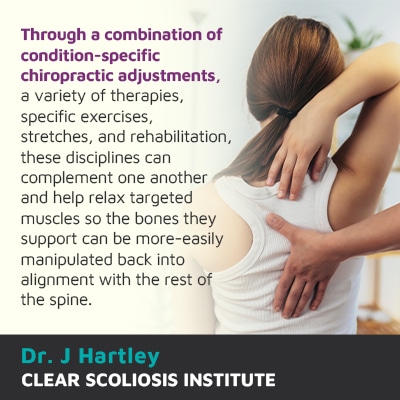
A spine with its healthy curves in place will appear straight from the front and/or back and have a soft ‘S’ shape when viewed from either side, and if those curves fall with a healthy range, this means that the spine’s vertebrae are aligned as they should be. If an unnatural spinal curvature develops, the spine is no longer aligned and can cause a number of symptoms felt throughout the body.
Part of the spine’s ability to function optimally is based on its natural curves and alignment. Hypolordosis refers to a loss of the spine’s healthy inward curve in the cervical or lumbar spinal sections, introducing uneven forces to the spine and its surroundings.
The spine has three main sections, and as the cervical and lumbar sections feature lordotic curves, let’s start there.
The spine has three main sections; the cervical spine refers to the neck, the thoracic spine includes the middle/upper back, and the lumbar spine refers to the lower back.
As the spine is one long connected structure, each spinal section’s curve is dependent on the health of the others, and while the thoracic spine’s curvature-type is kyphosis, the sections above and below feature lordotic curves.
Kyphotic curves bend outwards, away from the front of the body, while lordotic curves bend inwards, towards the front of the body.
The spine’s natural and healthy curves are key to its ability to function optimally, and there are a number of spinal conditions that cause a loss of its natural curves, including hypolordosis.
A diagnosis of hypolordosis means a healthy spinal curve has been lost, instead becoming excessively straight, and this introduces uneven forces and adverse tension to the spine and its surrounding nerves and muscles.

When there is a flattening of a spinal curve, this puts extra stress on the spine’s frontal plane, and this includes the spine’s vertebrae and intervertebral discs; this can cause compression of the vertebral bodies and the discs in between, causing the development of a noticeably-flatter back.
As the spine’s natural and healthy curves make it stronger, more flexible, and better able to handle mechanical stress, a loss of one or more healthy spinal curves disrupts the biomechanics of the entire spine, impacting how it functions.
As the spine’s surrounding muscles have the role of supporting the spine, an unnaturally-curved spine can also affect the nearby muscles by shortening or elongating them unnaturally, and this can disrupt the position of the pelvis.
Symptoms of hyperlordosis will depend on the section affected, so let’s start with the cervical spine.
Everyone has different spinal-curve sizes, but if a person’s level of lordosis falls beyond a typical range, either becoming over- or under-pronounced, problems occur that need to be addressed.
The cervical spine has to support the weight of the head and is the bridge between the brain and the rest of the body; if the neck loses its natural lordosis, becoming excessively flat, this is diagnosed as cervical hypolordosis.
A related condition called military neck can develop as a result of the flattening of the cervical curve, and this is named after the look of militant soldiers standing up excessively straight.
Another condition that can develop due to the loss of healthy lordosis in the neck is what’s known as forward head posture, and this involves a change in the cervical spine’s ability to support the weight of the head because of the postural shift it causes.
Hypolordosis of the cervical spine can affect people differently based on causation and severity.
With most spinal conditions, the area of the body located closest to the affected spinal section is the area that’s going to feel the majority of its direct effects, so when it comes to a flattening of the cervical curve, the head, neck, upper shoulders, and arms are the most affected.
Common symptoms of cervical hypolordosis can include:
When the vertebrae of the cervical spine become unnaturally straight, this means they are no longer aligned with the rest of the spine, and this impacts the spine’s strength and function.
Each of the spine’s main sections has its own unique characteristics, curvature type, and role, and when it comes to the lumbar spine, the lower back has to support the weight of the trunk, the thoracic and cervical sections above, and the lumbar spine also feels the effects of a variety of movements (bending, lifting, and twisting motions).
When the lumbar spine loses its healthy range of lordosis and becomes excessively straight, this can lead to the development of a condition known as flatback syndrome.
Flatback syndrome involves a disruption to the lower spine’s stability and balance, making it unstable, and this can make the lower back’s vertebrae and intervertebral discs particularly vulnerable to degenerative changes and injury.
Common symptoms of hypolordosis of the lumbar spine can include:
When the spine loses a natural and healthy curve, treatment has the goal of restoring as much of the spine’s healthy curves as possible as this reduces the condition’s uneven forces and adverse spinal tension.

When it comes to treating hypolordosis of the lumbar spine, we’re talking about restoring as much flexibility and range of motion in the lumbar spine as possible, through restoring a healthy range of lordosis.
Here at the CLEAR Scoliosis Institute, we believe in applying an integrative treatment approach because relying solely on one form of treatment isn’t as effective.
Through a combination of condition-specific chiropractic adjustments, a variety of therapies, specific exercises and stretches, and rehabilitation, these disciplines can complement one another and help to relax targeted muscles so the bones they support can be more-easily manipulated back into alignment with the rest of the spine.
Physical therapy and specific exercises are also used to increase muscle strength and flexibility, while activating certain areas of the brain that are involved in controlling posture, balance, and coordination to achieve postural remodeling and a healthier body position.
Treatment will involve an X-ray at its onset and its completion to ensure a healthy level of lordosis has been restored.
When it comes to spinal health, maintaining its healthy curves is important because if a healthy curve is replaced by a bad curve, this introduces adverse spinal tension, can disrupt the biomechanics of the entire spine, and increase rates of spinal degeneration.
Lordosis refers to the spine’s inward curves in the cervical and lumbar sections of the spine; kyphosis refers to the spine’s outward curve in the thoracic spine.
A diagnosis of hypolordosis means a flattening of the lordotic curve has developed, and this can affect the cervical and/or lumbar spine.
A loss of lordosis in the cervical spine can lead to military neck, and a loss of lordosis in the lumbar spine can cause the development of flatback syndrome.
Military neck refers to the appearance a loss of cervical lordosis can cause as the neck becomes excessively and unnaturally straight; forward head posture involves the misalignment of the cervical spine so the head leans excessively forward, increasing the weight of the head on the neck significantly.
Hypolordosis means the spine has lost a curve as it’s become excessively straight, and this puts pressure on the spine and its surroundings; when it comes to restoring a healthy range of lordosis, we’re talking about proactive treatment that uses chiropractic care to manually adjust the position of affected vertebrae, plus the power of physical therapy and condition-specific exercises/stretches to strengthen muscles that support, and are affected by, the spine’s alignment.
As a CLEAR-certified scoliosis chiropractor, I have experience treating a wide range of spinal conditions, hypolordosis included, and the most important thing is determining its underlying cause and addressing it proactively.

CLEAR provides a unique and innovative way of understanding scoliosis. Sign up to receive facts and information you won’t find anywhere else.
